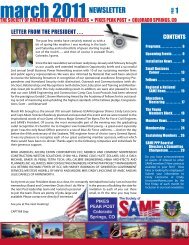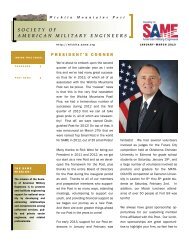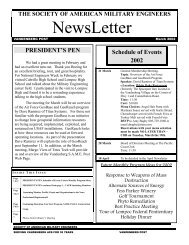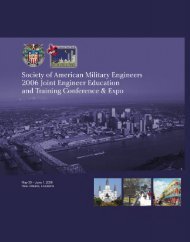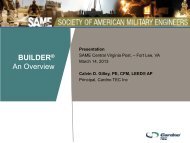june 2011 NEWSLETTER - Chapter - Society of American Military ...
june 2011 NEWSLETTER - Chapter - Society of American Military ...
june 2011 NEWSLETTER - Chapter - Society of American Military ...
Create successful ePaper yourself
Turn your PDF publications into a flip-book with our unique Google optimized e-Paper software.
<strong>june</strong> <strong>2011</strong> <strong>NEWSLETTER</strong> 11<br />
INSTALLATION NEWS<br />
USACE Releases FY<strong>2011</strong> Civil<br />
Works Work Plan<br />
So, we’re a couple weeks late on this, but seeing as though<br />
we were so busy preparing for last week’s <strong>2011</strong> Joint Engineer<br />
Training Conference & Expo, I hope you’ll cut us some<br />
slack. It seems that back in mid-May, the U.S. Army Corps <strong>of</strong><br />
Engineers (USACE) released its work plan for the Army Civil<br />
Works program through the end <strong>of</strong> FY<strong>2011</strong>. According to a<br />
Corps press release, the plan “details how USACE will execute<br />
the $5.065 billion Civil Works appropriation it received<br />
on April 15 when President Barrack Obama signed Public<br />
Law 112-10, the Department <strong>of</strong> Defense and Full-Year Continuing<br />
Appropriations Act, <strong>2011</strong>.”<br />
Among other items, the $5.065 billion in FY<strong>2011</strong> funding<br />
is distributed among USACE Civil Works appropriation accounts<br />
as follows:<br />
•<br />
•<br />
•<br />
•<br />
•<br />
•<br />
•<br />
$2.371 billion for Operation and Maintenance (O&M)<br />
$1.793 billion for Construction<br />
$264 million for Mississippi River and Tributaries<br />
(MR&T)<br />
$190 million for the Regulatory Program<br />
$185 million for Expenses<br />
$130 million for the Formerly Utilized Sites Remedial<br />
Action Program (FUSRAP)<br />
$127 million for Investigations<br />
The work plan was released as a PDF document broken<br />
down into separate line items organized by appropriation<br />
account, then state. USACE also released a principles document.<br />
To obtain the documents, please visit SAME at http://<br />
militaryengineers.wordpress.com/<strong>2011</strong>/06/02/usace-releases-fy<strong>2011</strong>-civil-works-work-plan/.<br />
Peterson AFB News<br />
Peterson Dorms Shine Light On Energy<br />
Savings<br />
2nd Lt. Grant Packard, Peterson Energy Program manager<br />
PAGE<br />
Earlier this month, the Peterson AFB dorms completed an<br />
energy conservation project that has been ongoing for the<br />
past year, and unless you are a resident, you may not have<br />
noticed.<br />
The Peterson dorm management replaced all <strong>of</strong> the incandescent<br />
light bulbs with brand new, energy efficient, compact<br />
fluorescent light bulbs, or CFLs. This project began<br />
when the unaccompanied housing manager, Master Sgt.<br />
Mark Murphy, wanted to find a way to help with the basewide<br />
energy awareness campaign in December 2010.<br />
At that time, the dorms were still using the inefficient incandescent<br />
light bulbs, which use approximately 75 percent<br />
more energy than modern CFLs. With the help <strong>of</strong> Jim<br />
Jacobsen, the 21st Space Wing energy manager, Sergeant<br />
Murphy was put into contact with Colorado Springs Utilities.<br />
CSU had just begun a city-wide energy awareness campaign<br />
through Project Smart Light and provided 1,100 CFLs<br />
for the dorms at no cost to Peterson AFB. The first energy<br />
efficient light bulb was installed in January <strong>2011</strong>. After four<br />
months <strong>of</strong> replacing incandescent light bulbs in all four<br />
dorm facilities, the project was completed in April.<br />
The Project Smart Light campaign has since ended with the<br />
Peterson dorms being the last large group to receive the<br />
free CFL upgrades. Even though no other base facilities will<br />
be eligible for this program, the dorm project alone will provide<br />
approximately 77,000 kWh per year in energy reduction,<br />
which amounts to around $4,000 in savings annually.<br />
Additionally, these new light bulbs will last five times longer<br />
than their old counterparts, providing either further savings<br />
down the road




